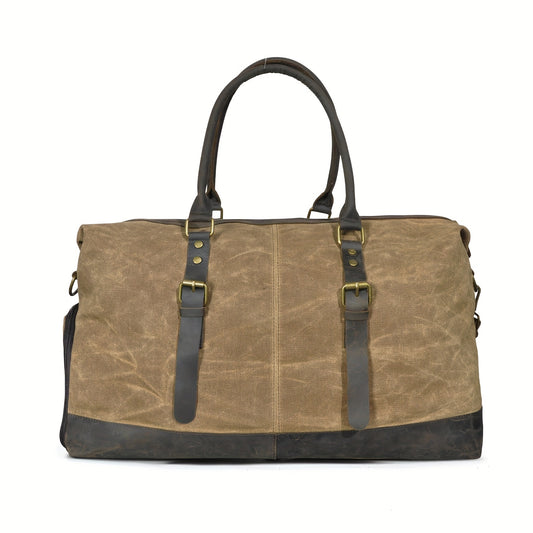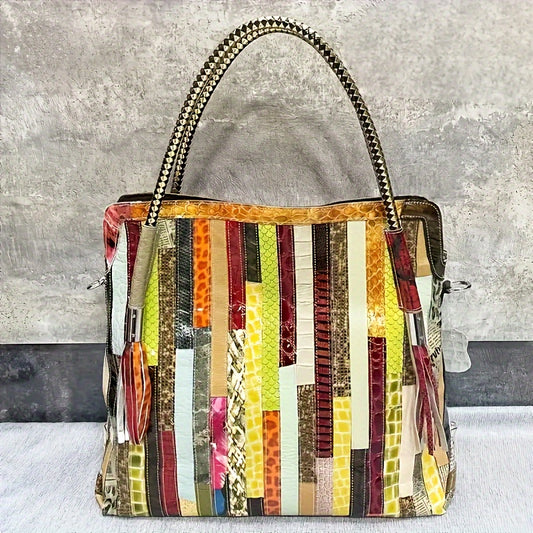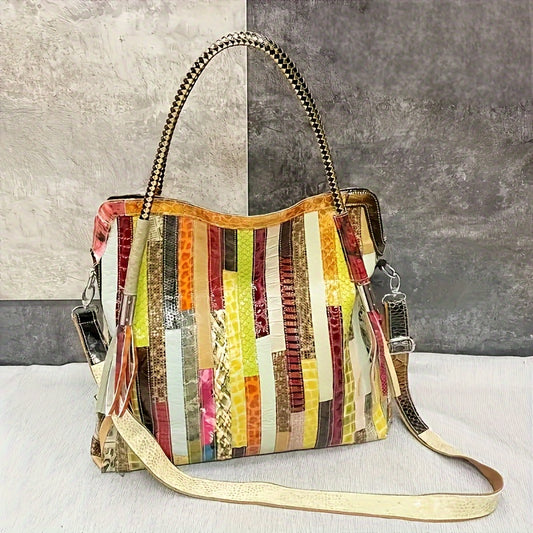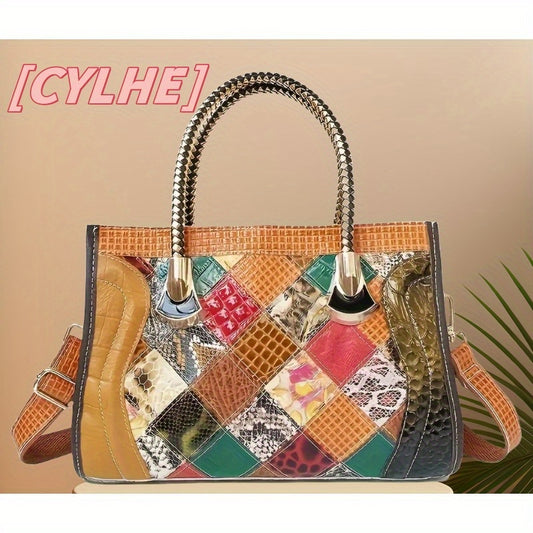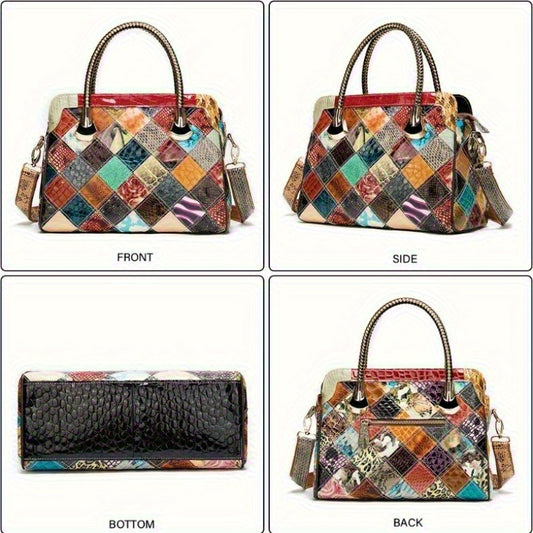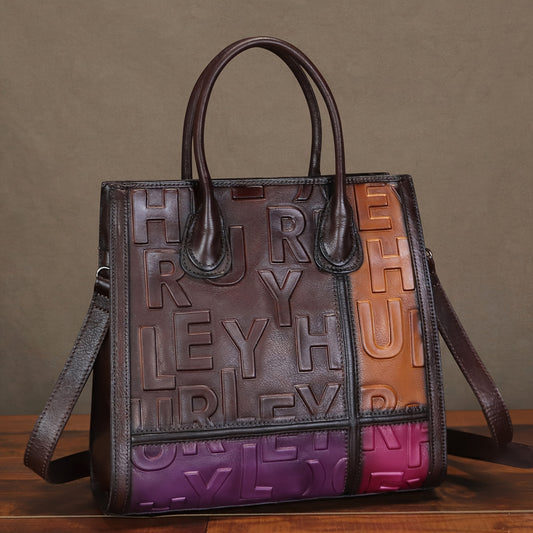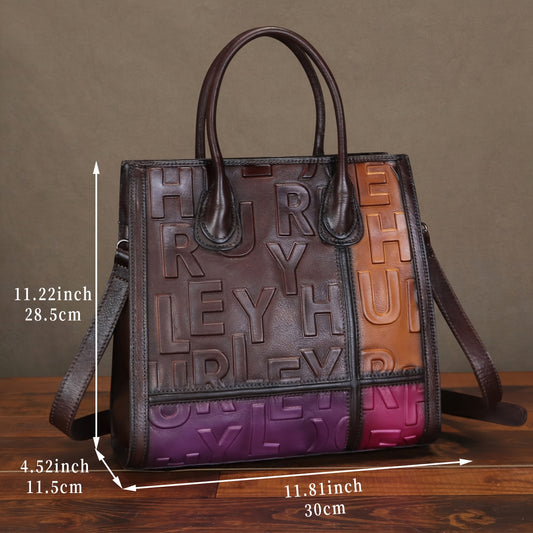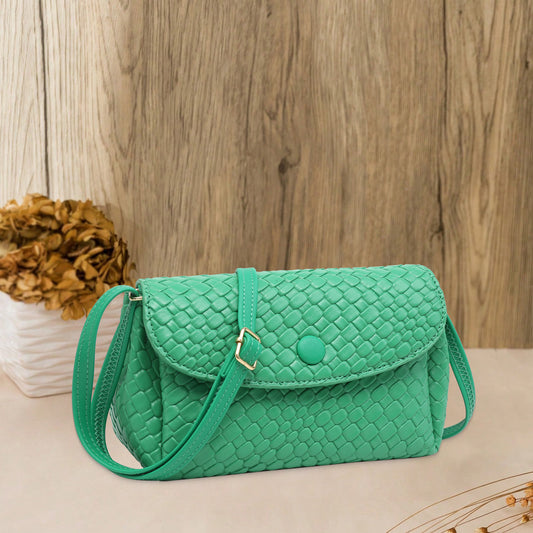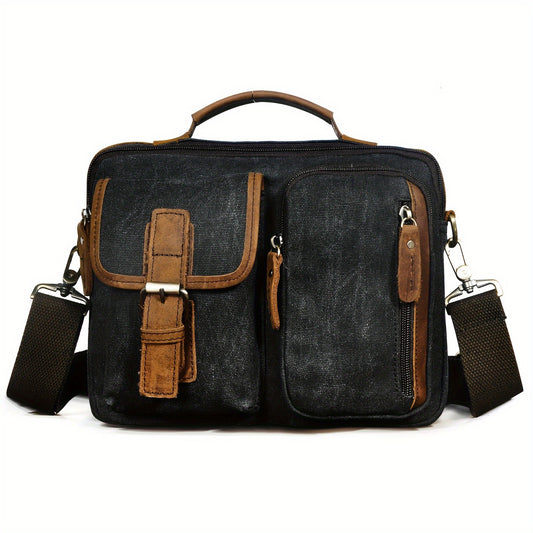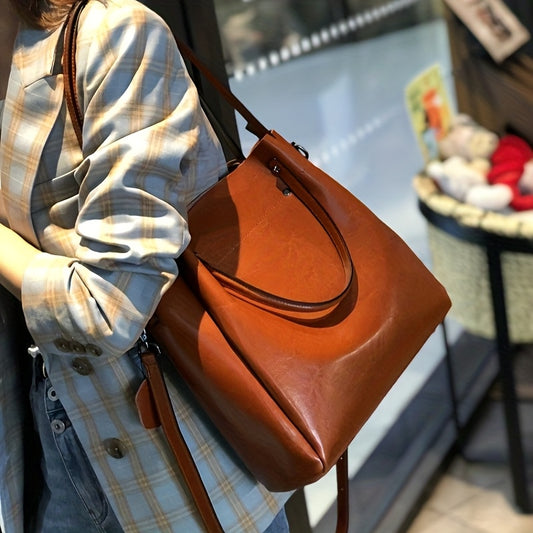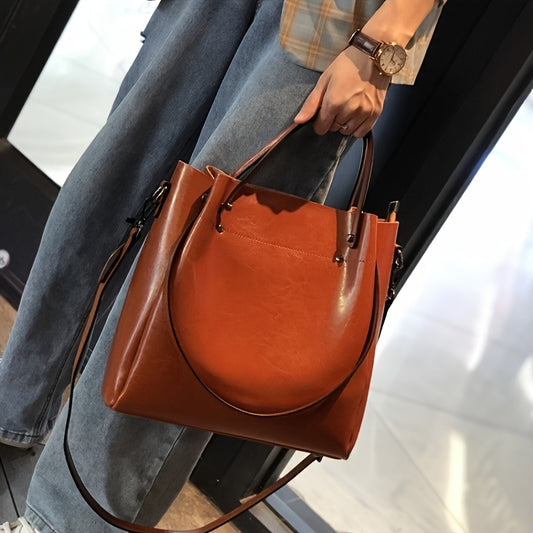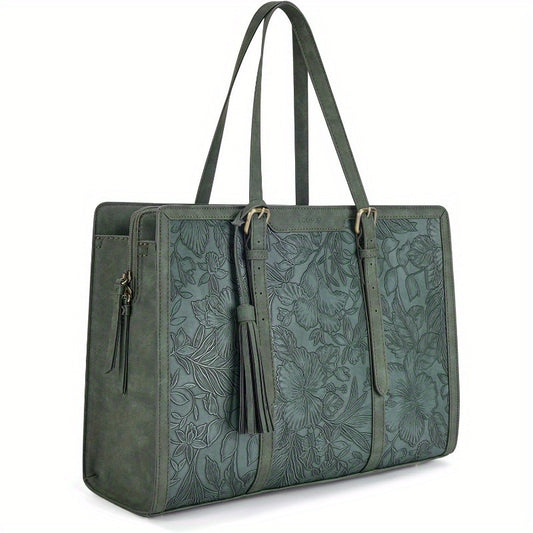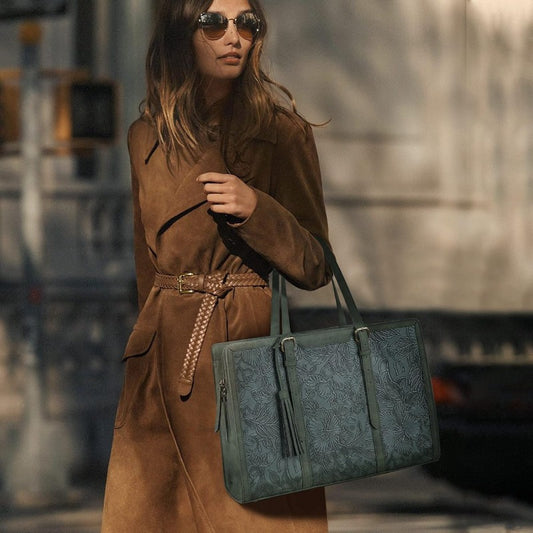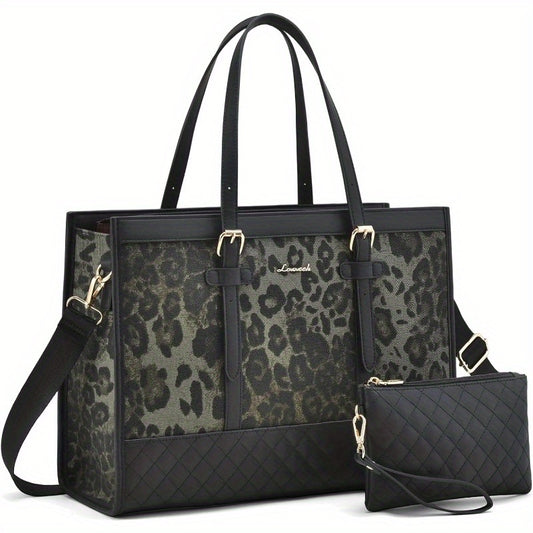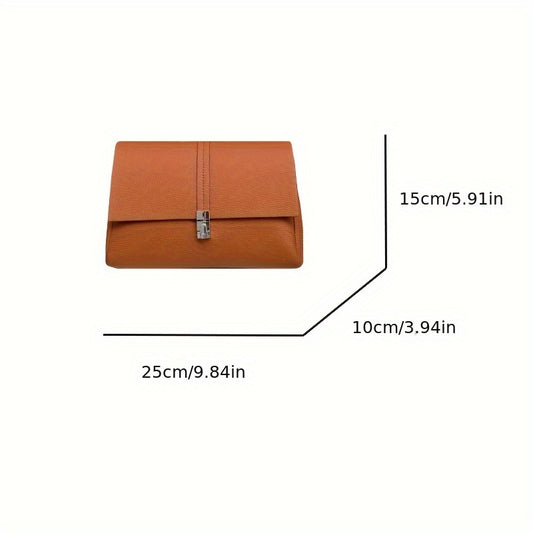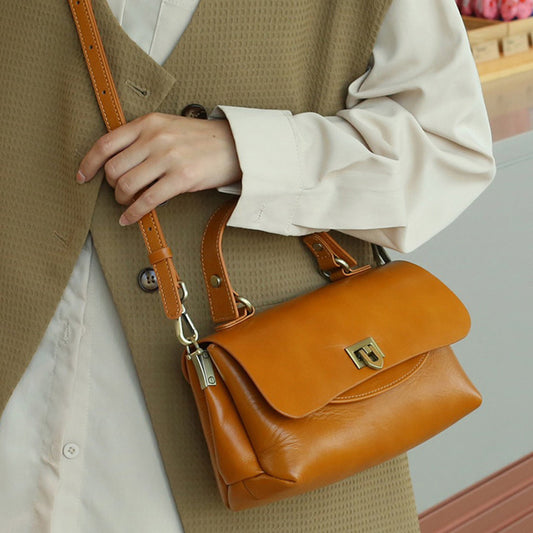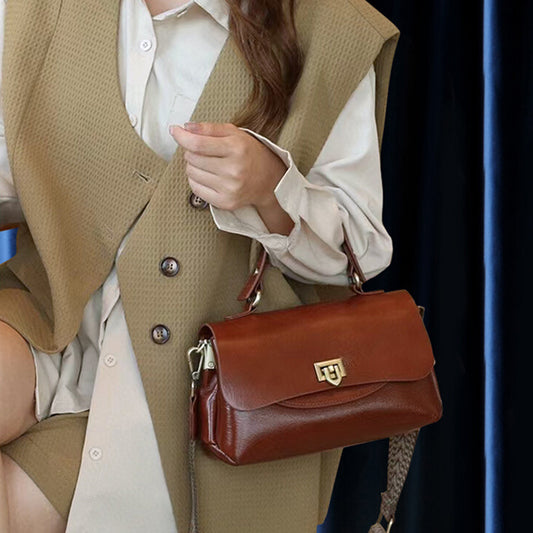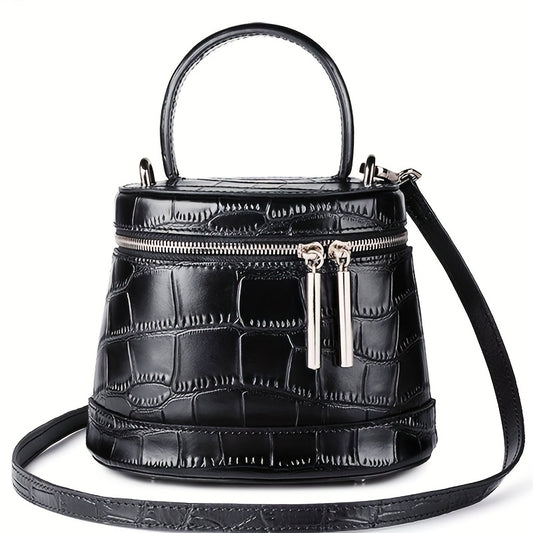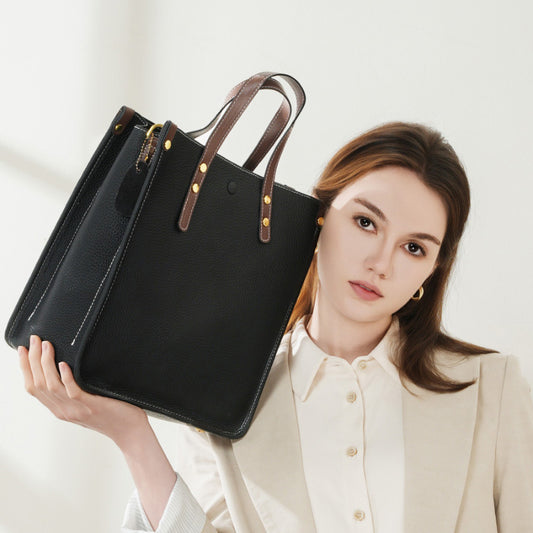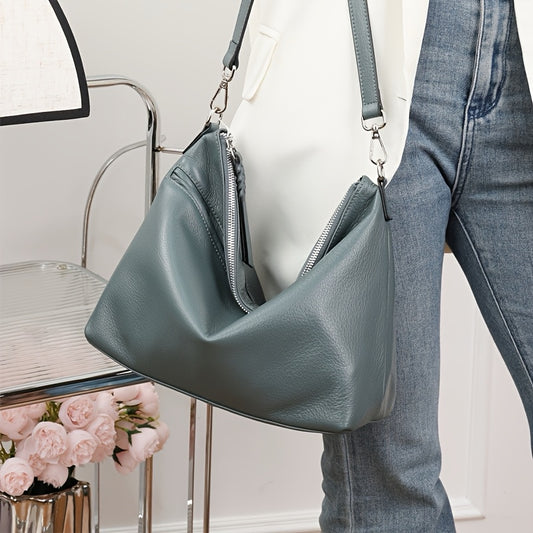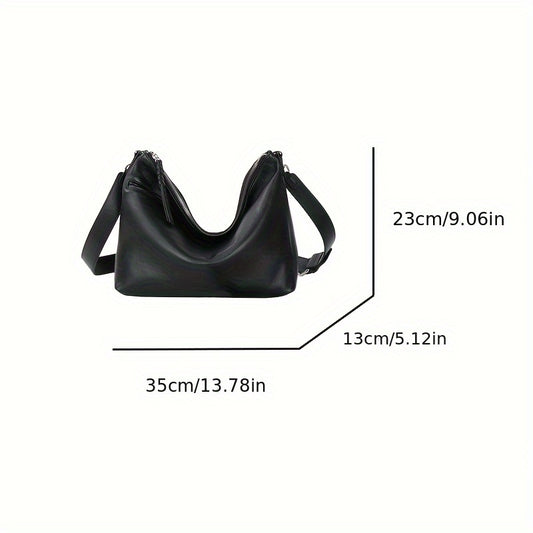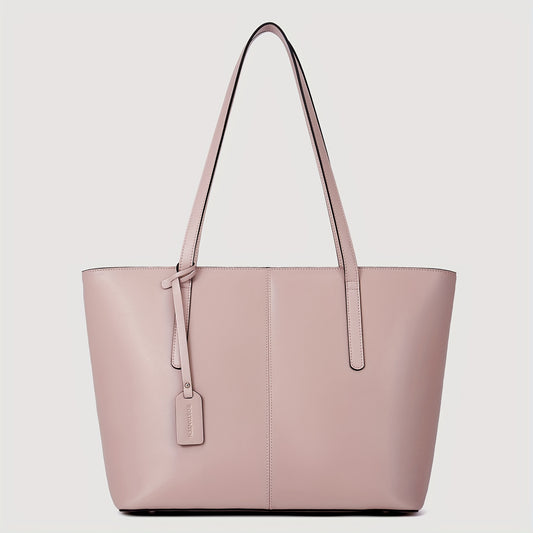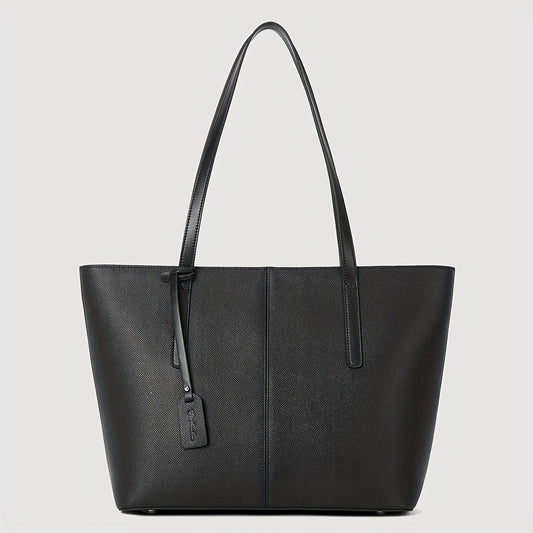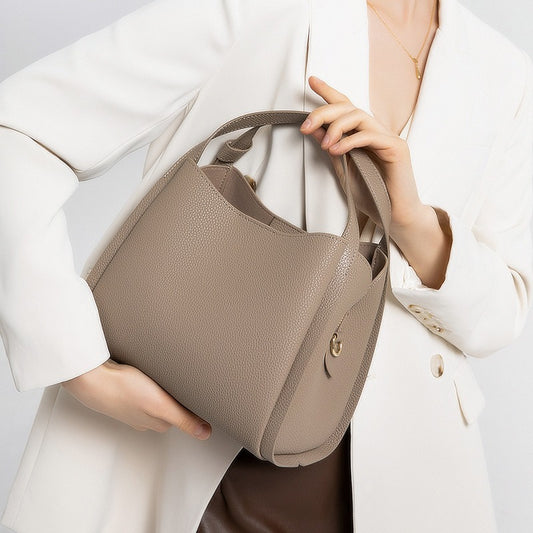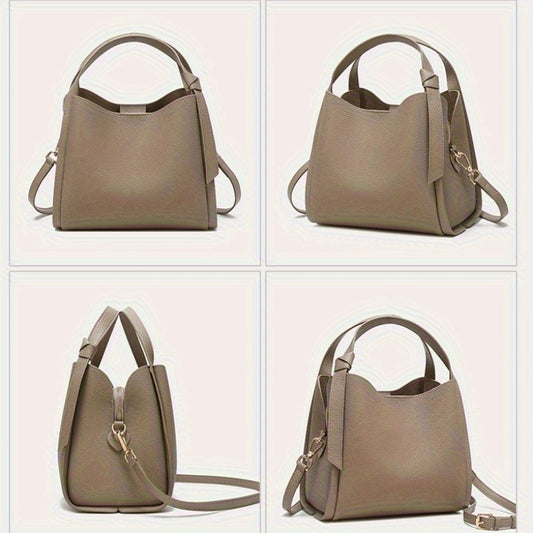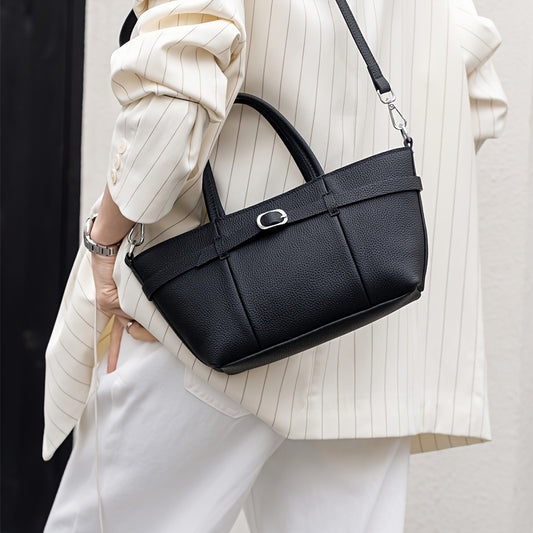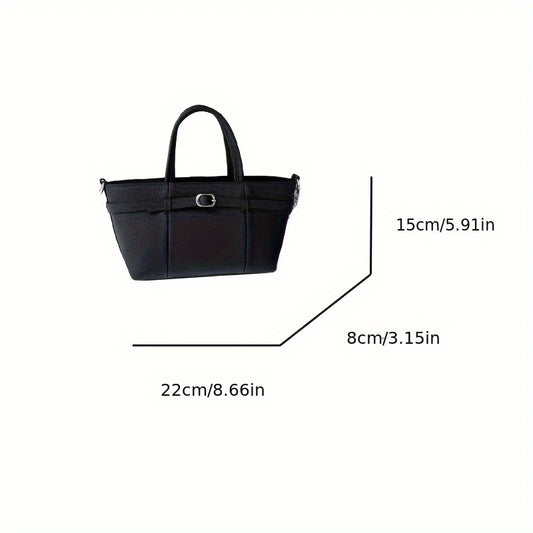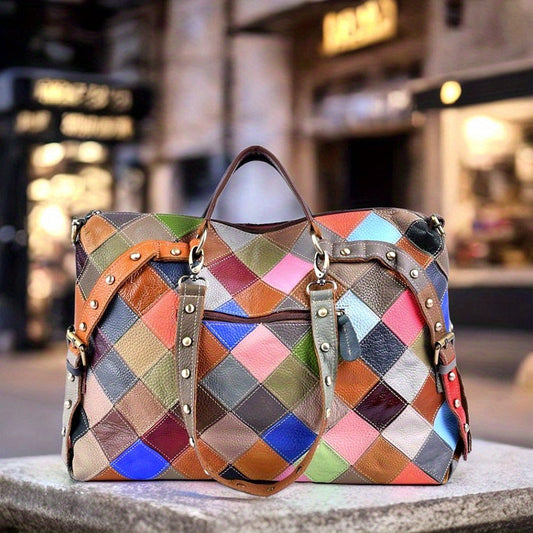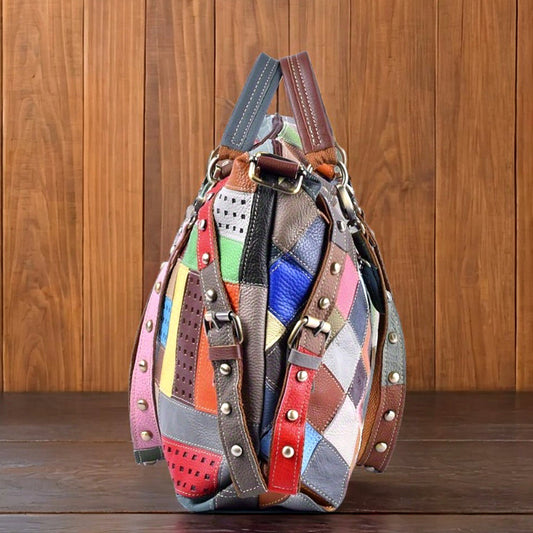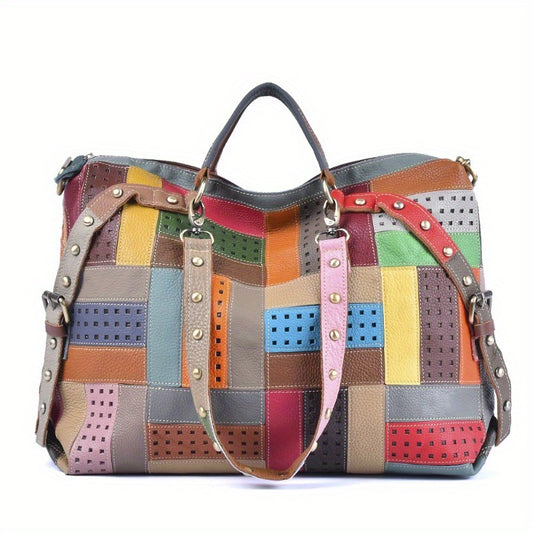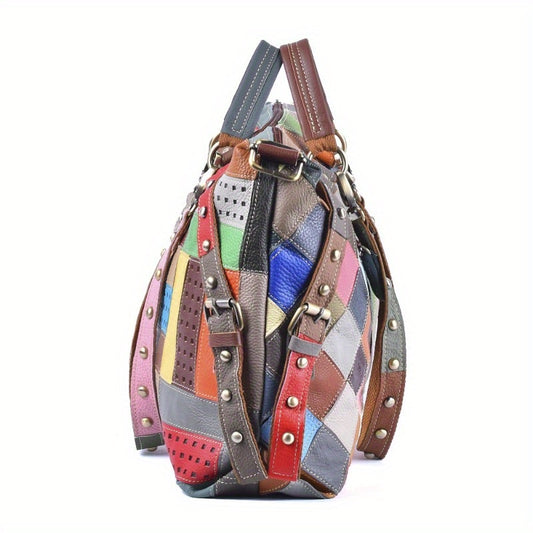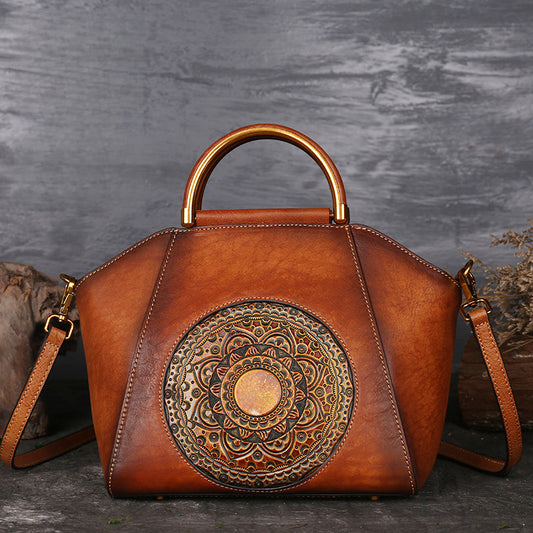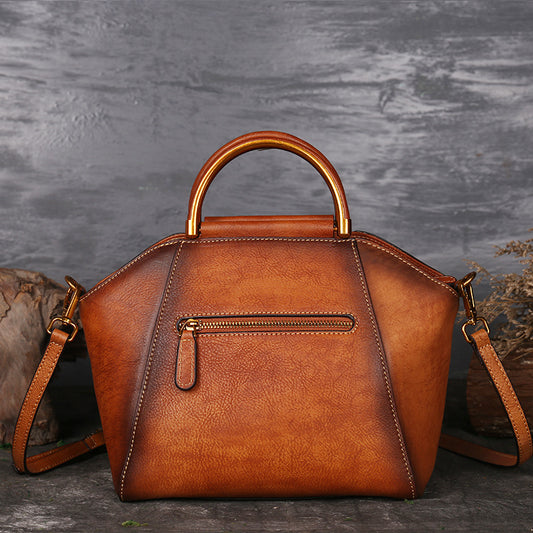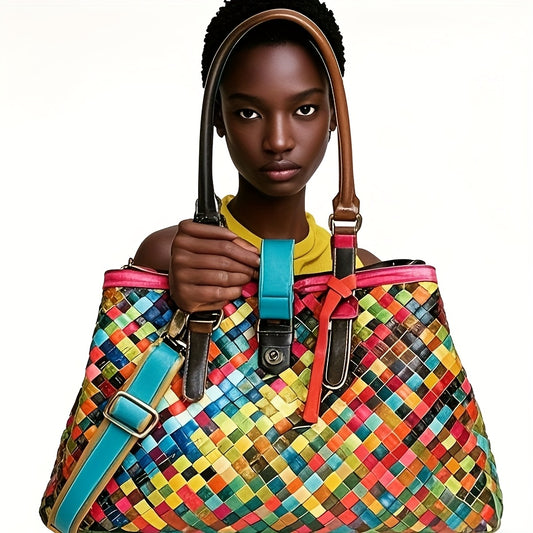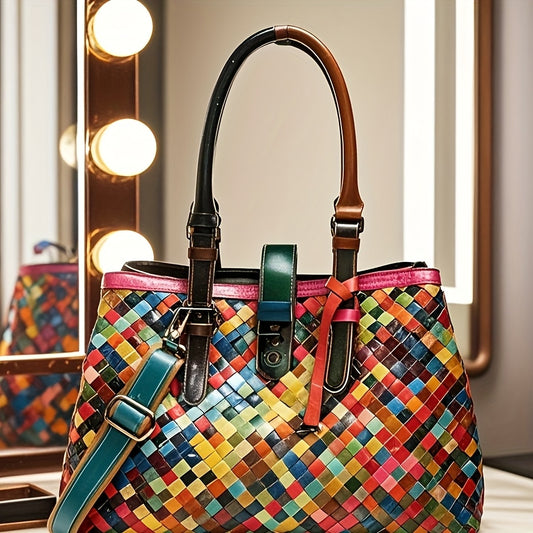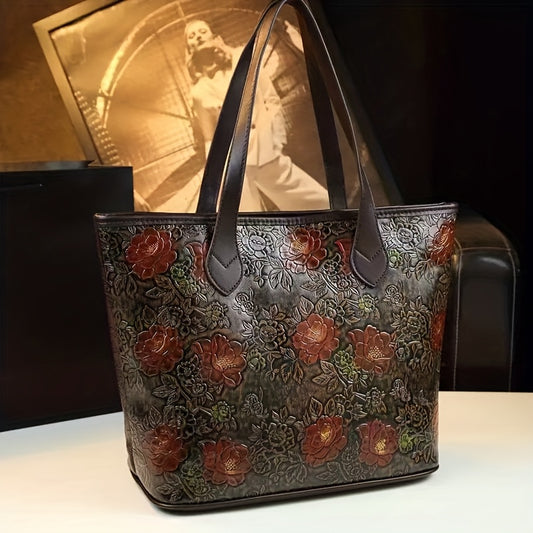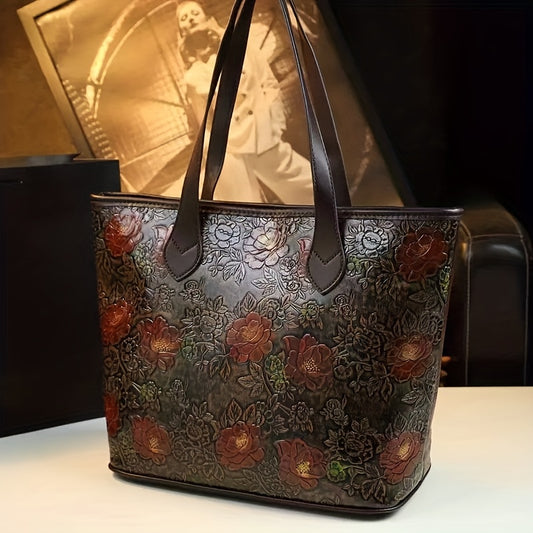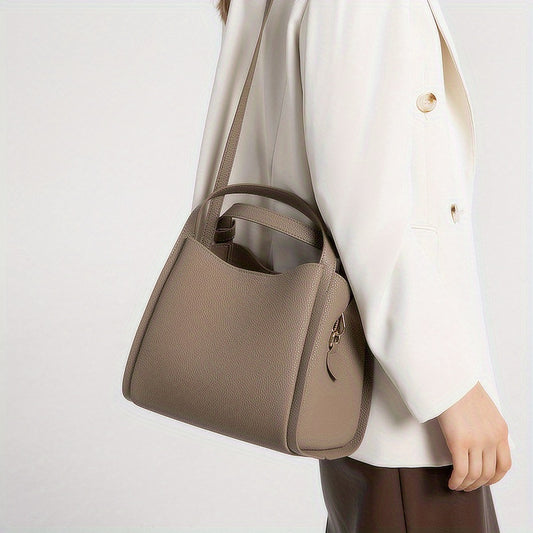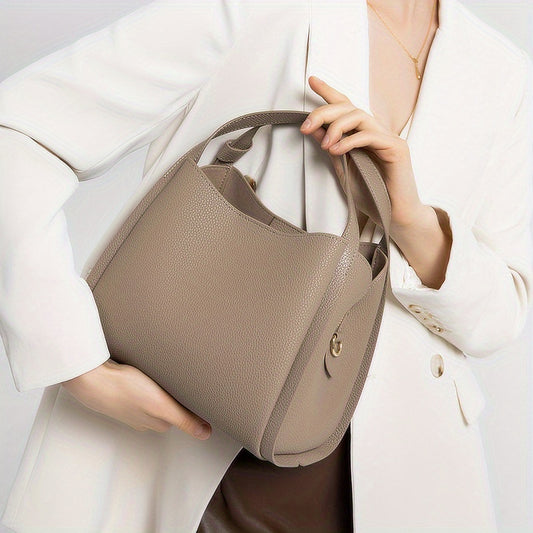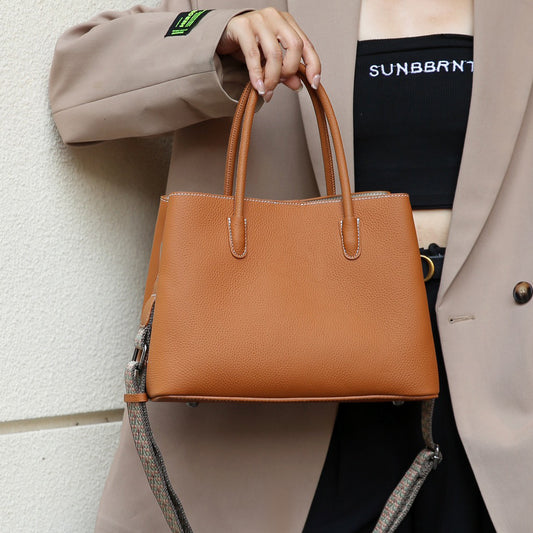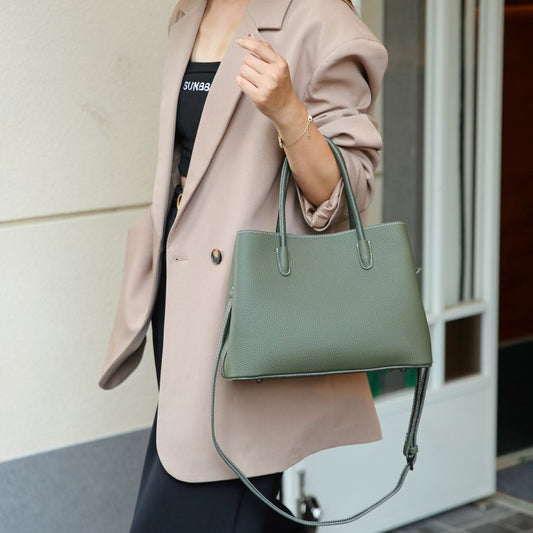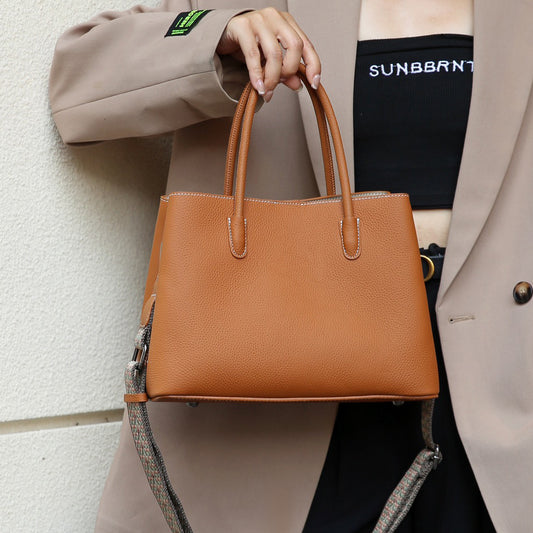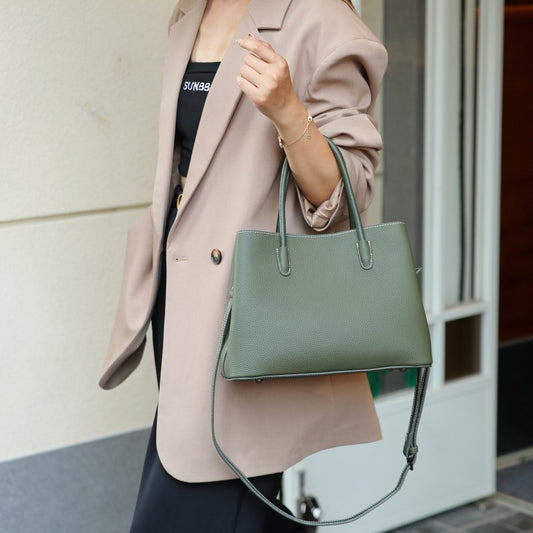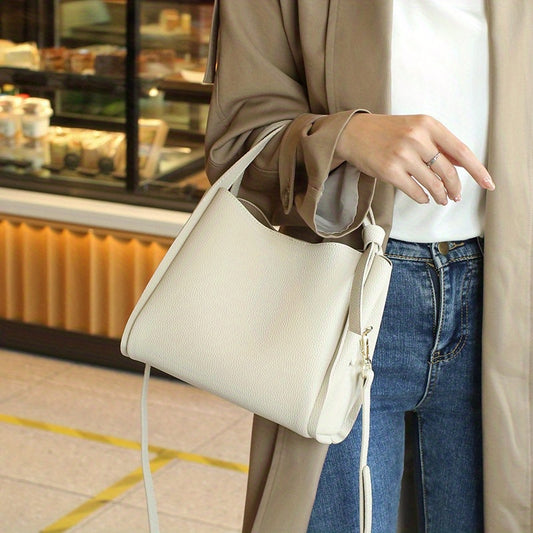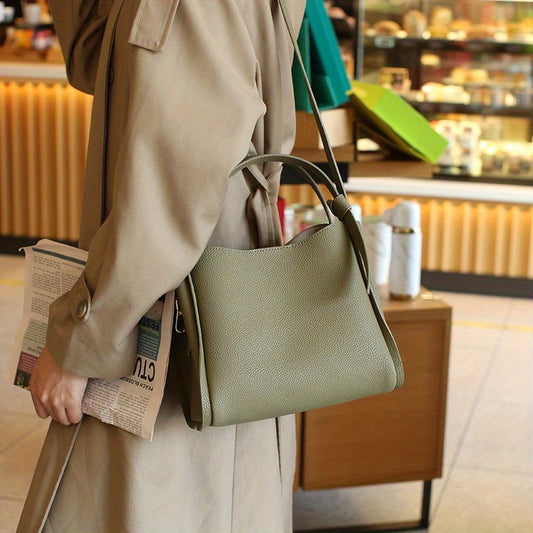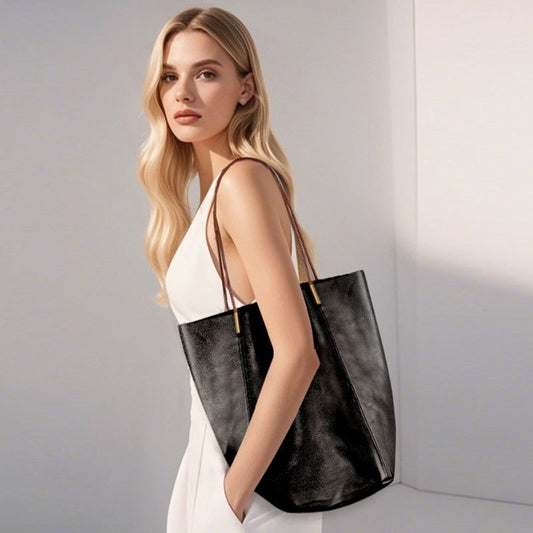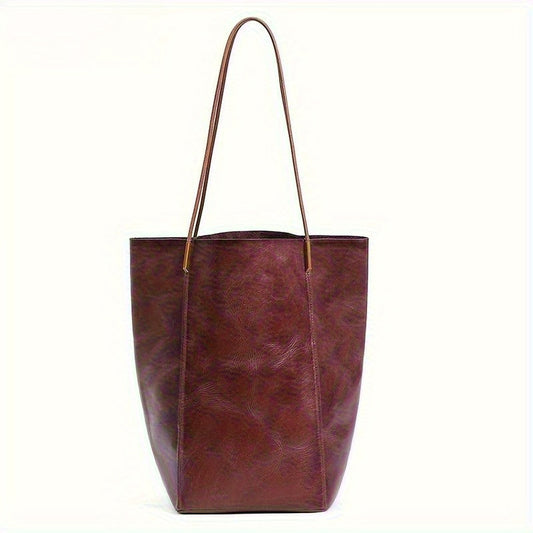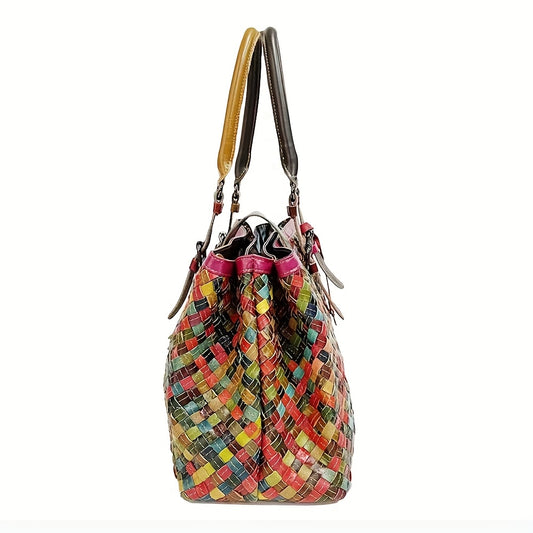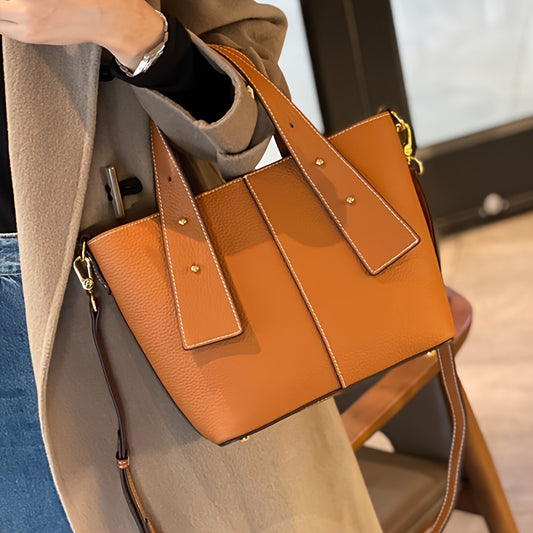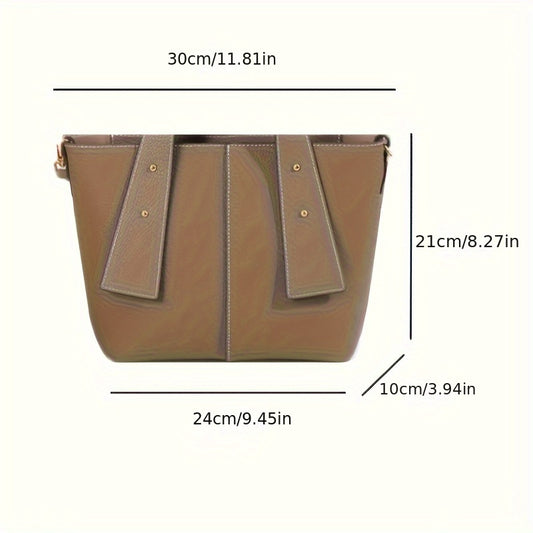About Green Leather Tote Bag
The Complete Guide To Green Leather Tote Bags For Women
Green leather tote bags combine the quiet confidence of a workhorse carryall with the aesthetic lift of a carefully chosen color. Unlike purely trend-driven accessories, a tote is judged by how well it handles real life: laptops and notebooks at 9 a.m., a lunch container at noon, a last-minute gift at 5 p.m., and plane tickets by midnight. Choosing the shade of green adds a cultured note—olive for grounded utility, forest for cool winter depth, sage for a minimalist mood, emerald for event polish, and mint for spring freshness. This comprehensive guide distills everything you need to know: color psychology, leather types, construction quality, strap engineering, interior architecture, laptop logic, sizing and fit, maintenance that actually works, repair and longevity strategies, sustainability trade-offs, price-to-value thinking, travel security, and styling playbooks for office, weekend, and events. Along the way, we reference how the “Green Leather Tote Bag” collection is organized so you can map these ideas to concrete options and filters while you shop. (Fabulive)
Why Green Works Year-Round
Green reads like an elevated neutral because the eye already accepts it in nature. It complements denim and navy, warms up camel and ivory, anchors winter charcoal, and punctuates eventwear without screaming for attention. Olive projects quiet confidence and bonds instantly with utility jackets, trench coats, and leather boots. Forest feels architectural next to crisp tailoring, wool coats, and ribbed knits. Sage plays beautifully with oatmeal, stone, and warm grey, which is why it shows up in minimalist wardrobes and contemporary interiors. Emerald is the jewel-tone exception that turns a simple look into an occasion outfit. Mint is playful, best in compact sizes when you want the tote to register as a fresh note rather than the whole melody. Because green sits in the middle of the visible spectrum, it photographs reliably indoors and outdoors; the color neither flares like neon nor collapses into darkness under evening LEDs.
What Distinguishes A Tote From Other Bags
A tote is defined by volume, a wide mouth, and top handles that invite shoulder carry. Where satchels emphasize structure and crossbodies emphasize mobility, totes must reconcile space with stability. The good ones stand upright when you set them down, resist sag at the base, and open widely enough that you can see and reach items without the dreaded internal treasure hunt. Zip-top versions trade a whisper of elegance for real-world security on trains and planes. Center-zip or center-divider layouts create two logical zones for tech and personal items. A narrow profile keeps your silhouette clean on crowded sidewalks; a wider base welcomes lunch containers, makeup pouches, and a water bottle without tipping.
A Quick Look At The Collection Structure
On the collection page, navigation makes it easy to shop by color and function. Within Leather Handbags → For Women, the color filter includes a dedicated “Green Leather Tote Bag,” and specialty categories nearby such as “Woven Leather Tote Bag,” “Leather Tote Bag With Zipper,” “Leather Laptop Tote Bag,” “Soft Leather Tote Bag,” “Canvas And Leather Tote Bag,” and related crossbody or travel options. That taxonomy lets you shortlist by need—security, texture, or device carry—before you ever zoom into a product card. (Fabulive)
Leather Fundamentals: From Hide To Handbag
Full-Grain Leather preserves the natural grain and the strongest fiber structure. It wears in (not out), gaining a patina that deepens green tones, especially olive and forest. Choose full-grain when you want character and longevity; accept natural markings as part of the charm. Top-Grain Leather is lightly corrected for a smoother face, balancing durability with a refined look and very consistent color—useful for sage or mint that should remain even across large panels. Corrected-Grain Leather accepts embosses (saffiano, basket, croc) and pigmented finishes that increase scratch resistance for daily commuting. Nappa refers to a soft, smooth hand; it looks sleek on structured totes that hide stiffeners inside. Pebbled leather diffuses micro-scratches and conveys a plush, everyday luxury. Saffiano leather, with its cross-hatch and resin finish, is the scuff-resistant champion, ideal for rain-prone cities and heavy shoulder loads.
Tanning And Finishing: Why It Changes Care
Vegetable Tanning relies on plant tannins; it starts firmer and develops a handsome patina but can be more sensitive to water in the first months. Chrome Tanning is faster and often yields a softer hand and uniform color stability—great for bright emerald and uniform sage. Combination Tanning blends the best of both, crafting daily-friendly leathers that still age gracefully. Aniline finishes highlight natural character (and show marks sooner); semi-aniline adds a thin protective layer; pigmented finishes maximize stain resistance and colorfastness—especially useful for large green panels that must look even under different lights.
Texture Amplifies Color
Smooth emerald reads couture-clean; pebbled olive feels relaxed and quietly luxe; saffiano sage looks modern and office-friendly; croc-embossed forest amplifies depth because raised scales catch light; woven moss creates a grid of highlights and shadows that telegraphs craftsmanship. If you want stealth luxury for the office, pick fine pebbled olive or semi-aniline sage. If you attend dinners and presentations, croc-embossed emerald with polished hardware delivers a sophisticated focal point. If you prioritize scratch forgiveness, pebbled or saffiano buys peace of mind.
Anatomy Of A Long-Wearing Tote
Panels are cut, skived (thinned at edges), stitched, and edge-finished to resist friction. Look for clean stitch density (roughly 6–10 stitches per inch on visible seams), symmetrical panel alignment (a zip mouth that doesn’t ripple), reinforced base support (thin board + liner + optional feet), and bar-tacked or box-stitched stress points at handle roots and strap tabs. Edge paint should feel smooth with no pinholes; oil-edged leathers should show even burnishing and cured layers. Inside, taped seams and bound pocket edges signal an attention to fray-prevention. When you set the tote down, it should neither collapse like a grocery bag nor stand so rigid that it bruises your thigh when you walk.
Handle And Strap Engineering
Handles carry most of the load. Turned-edge handles with internal reinforcement and soft padding distribute pressure across the shoulder. A 9–11 inch handle drop is the sweet spot for blazers and light jackets; 11–13 inches accommodates winter coats. Check the handle cross-section: flattened rectangles stay comfortable longer than razor-thin strips. If the tote includes a longer strap, note the attachment geometry—D-rings placed apart keep the body flat against you; a swivel reduces twisting; a 1–1.25 inch strap width prevents digging on heavy days. If a strap is removable, the bag can moonlight as a cleaner top-handle silhouette for presentations and dinners.
Closures And Everyday Security
Open totes provide the fastest access but require an interior zip pocket for valuables. Zip-top totes are the commuter’s ally; ensure the zipper runs straight with a clean end anchoring so it won’t snag at corners. Magnet flaps are tidy and reduce visual clutter. Some laptop totes incorporate a trolley sleeve for rolling luggage; prioritize that if you fly frequently—your shoulders will thank you at gate changes.
Interior Architecture That Prevents Chaos
Practical layouts corral your items into predictable zones. A padded 13-inch sleeve covers most work laptops; measure yours (width and thickness) if it’s a 15-inch class device. A central zip divider creates two compartments that naturally separate tech from personal items. A zip pocket protects passport and keys; slip pockets near the mouth capture phone and transit card. An elasticized bottle sleeve avoids internal spills and condensation rings at the base. If you carry sunglasses in a rigid case, check the mouth clearance; a narrow opening can fit width but block the case at the opening.
Capacity Planning By Lifestyle
Commute Core: laptop, power bank, charger, notebook, pen case, slim water bottle, keys on a leash, cosmetics pouch, card wallet. Teacher/Healthcare: planner, pens and markers, hand sanitizer, snack pouch, foldable flats, badge lanyard; favor wipe-clean linings and zip tops. Creative Workday: tablet with pencil, A4 sketch pad, washi sampler, compact camera; choose a reinforced base so corners don’t poke the exterior. Parent Hybrid: spare T-shirt, wipes, squeeze pouch, child’s water bottle, band-aids, travel-size sunscreen; zip top + bottle sleeve is non-negotiable. Overnight: knit set, underlayers, a slim toiletry kit; use a divider to keep clothing away from tech and makeup.
Shade-By-Shade Playbook
Olive: The utility neutral—works with denim, navy, camel, ivory, black, rust. Antique brass hardware warms it; pebbled textures feel plush. Forest: Deep and cool—ideal with charcoal tailoring and winter outerwear; polished gold or gunmetal hardware sharpens the line. Sage: Minimal and modern—pairs with stone, oatmeal, warm grey; brushed nickel makes it feel architectural. Emerald: Event-ready—scale the tote smaller for dinners; croc emboss telegraphs intention without shouting. Mint: Fresh and playful—best as a small or medium tote in spring; polished nickel keeps it crisp. Moss: Earth-rich—handsome against tan trenches and dark indigo; woven construction suits the mood.
Hardware Finishes And Styling
Polished Gold lights up emerald and forest, creating an instantly dressy register. Antique Brass flatters olive and moss, suggesting heritage and travel readiness. Brushed Nickel looks sleek with sage and works well in offices with a pared-back aesthetic. Gunmetal lends urban polish to forest and deep moss. Mixed metals can work if you repeat them intentionally with a watch or belt; otherwise, keep the palette consistent so the tote remains the focal point.
Weight, Balance, And All-Day Comfort
Leather is heavier than canvas; good engineering offsets this with internal stiffeners instead of thick, heavy exterior panels. Place your laptop against the side closest to your body and center other heavy items at the base. A 1–1.25 inch strap feels balanced under load; a chain looks lovely at dinner but is best reserved for smaller totes. If a tote tugs forward, shorten the handle drop one notch or redistribute interior weight so the heaviest items sit directly under the handle roots.
Lining Choices And Why They Matter
Unlined totes feel artisanal and light but expose the suede side of the leather to makeup, pens, and hand cream spills. Partially lined interiors protect high-wear zones (base and pockets) without sacrificing weight. Fully lined totes—common in saffiano and pebbled constructions—are most protective, easier to clean, and allow more built-in organization. Whichever you prefer, inspect how pockets are finished: bound edges resist fray, while raw cuts can curl or stretch.
Woven, Smooth, Pebbled, Or Saffiano—Picking By Use Case
Woven Leather signals craftsmanship and disguises micro-scuffs; it pairs best with simple outfits that let the texture speak. Smooth Nappa looks sleek but will show the story of your life sooner—lovely if you like patina. Pebbled Leather is the safe daily choice: forgiving, tactile, and plush in olive and moss. Saffiano is the commuter’s friend: shape-holding, wipe-clean, rain-tolerant, and office-ready. The “Woven Leather Tote Bag,” “Leather Tote Bag With Zipper,” “Soft Leather Tote Bag,” and “Leather Laptop Tote Bag” categories make these distinctions easy to shop in one view. (Fabulive)
Laptop Logic: Fit, Padding, Heat
Do not trust “13-inch” as a single metric; measure width, height, and thickness of your device plus the case. A good sleeve has padding on all sides and at the base, so the laptop doesn’t thud when you set the tote down. If you hop between meetings, favor a sleeve with a notch for easy grabs. After heavy processing, let your device cool before sealing it into a tightly packed sleeve; that reduces trapped heat and extends hardware life.
Weather And Colorfastness
Semi-aniline and pigmented finishes handle drizzle; blot and air-dry away from heat. Deep green leathers may transfer dye to light fabrics on very wet days, while dark denim can mark light sage or mint—be mindful at corners and against seams. Keep a foldable rain cover in a side pocket; it weighs almost nothing and keeps your base panel from water-spotting at café floors.
The Edge-Paint Story
Edge paint seals the raw edges of leather. Poor edge paint chips at bends, especially where handles flex. Look for even application, no pinholes, and clean chamfers. If you notice early micro-cracks, a cobbler can sand and re-edge before the damage spreads—small maintenance that can add years to the life of your tote.
Build Quality: Fast Checks In A Store
-
Zip Test: Run the zipper end-to-end quickly. Any corner snag is a warning. 2) Stand Test: Set the tote down empty—does it stand? 3) Handle Squeeze: Compress the handle; it should rebound and edges should remain smooth. 4) Base Press: Gently press the base: a slight give is fine; a collapsing mouth is not. 5) Pocket Reach: Reach for phone and keys without looking—if you can’t, the layout needs work. 6) Odor: Natural leather should smell clean, not chemical.
Sustainability Without Greenwashing
The most sustainable tote is the one you use constantly and can keep in circulation for years. Buy repairable designs: stitched handles (not glued only), replaceable hardware, accessible lining seams. Vegetable-tanned or combination-tanned leathers age handsomely; vegan alternatives in olive and sage offer uniform color and weather resistance, though they won’t develop patina. Support repair culture: re-edging, strap tab re-stitching, zipper slider replacement, and base reinforcement are modest investments compared to buying new. Reselling and donating extend life and multiply the utility of quality goods.
Price-To-Value Thinking
Price alone doesn’t predict satisfaction; construction and support do. In curated selections, genuine-leather green totes with clean edge finishing, straight zips, padded sleeves, and bound pocket edges represent fair value precisely because they compress decision time and reduce future repairs. Transparent taxonomy—separate views for woven, zip-top, soft, laptop, and canvas-hybrid totes—helps you compare like for like and reduces buyer’s remorse. That structure is visible in the way the collection and adjacent categories are presented, making it easier to move confidently from browsing to checkout. (Fabulive)
Online Buying With Fewer Surprises
Translate dimensions into everyday objects: hold a ruler to your laptop and sunglasses case, and compare to width/height/depth listed. Check mouth clearance; many returns happen because the opening is narrower than the body. Zoom interior photos and look for bound edges, tight lining, and tactically placed pockets. Confirm handle drop for winter coats. Read returns and aftercare; the promise of guidance later is part of a tote’s real value.
Travel-Proofing Your Routine
Pre-Trip: Lightly condition, check strap screws, tuck a microfiber cloth and a foldable rain cover into a side pocket. At Security: Place the tote flat; cables and liquids in a separate pouch prevent sticky surprises in the lining. In Transit: Wear the zipper facing your body; never hang heavy totes by one handle on crowded hooks. Hotel: Store away from radiators and windows; keep shape with light stuffing; avoid over-conditioning in dry, heated rooms.
How To Compare Two Totes In One Minute
Hold each by the handles at shoulder height—does one tilt forward more? Zip and unzip end-to-end—any snag? Align the mouth—does the zipper sit straight? Press the base—does it collapse? Try it on with your coat—does the handle drop feel right? Reach for the interior zip pocket without looking—can you find it? Decide based on comfort, interior logic, and wardrobe harmony.
Outfit Playbooks
Office Minimal: Charcoal pantsuit, ivory shell, forest zip-top tote with polished gold hardware, block-heel pumps. Creative Studio: Ecru denim, black rib tank, sage pebbled tote, low loafers, layered silver jewelry. Weekend Market: Linen shirt dress, olive woven tote, white sneakers; add a straw hat for open-air stalls. Dinner And Theater: Black knit dress, emerald croc-embossed mini tote, gold hoops, slingback heels. Airport Uniform: Black leggings, longline hoodie, trench, moss laptop tote with trolley sleeve; hands free at gates. Conference Day: Navy blazer, stone trousers, sage saffiano tote; it stands neatly beside your seat during panels.
Building Capsules Around One Green Tote
Monochrome Black/Grey Capsule: Forest tote as the single color accent; rotate with two coats and one scarf. Earth Capsule: Camel coat, cream knit, rust skirt; olive tote blends seamlessly and looks intentional. Stone Capsule: Oatmeal knit set, warm grey trousers; sage tote completes the palette without overpowering. Jewel Capsule: Emerald tote with sapphire blouse and aubergine skirt; keep metals consistent for cohesion. Denim Capsule: Dark indigo jeans, white tee, navy blazer; moss tote finishes every look without fighting the blues.
Care Calendar You’ll Actually Follow
Monthly: Empty crumbs, wipe the exterior dry, clean handle darkening from skin oils. Quarterly: Lightly condition full- or top-grain; test an inconspicuous spot first; go sparingly on light sage to avoid darkening. Biannually: Check edge paint and handle roots; tighten screw-back hardware; reshape with acid-free tissue; rest in a breathable dust bag. Immediately: Blot rain spots, never rub; air-dry away from heat; use a green-matched balm for deeper scuffs; avoid hairdryers completely. Storage: Stand upright with the base supported; don’t hang a full tote by handles for weeks.
Mistakes That Shorten Tote Life
Overfilling daily; hanging on door hooks by a single handle; storing near windows in direct sun; tossing keys without a key leash; letting pens roam without a loop; ignoring early edge-paint cracks; using harsh cleaners; skipping periodic rest days so the bag can recover shape.
Reading Product Photos Like A Pro
Look at corners and mouth ends first; that’s where stress reveals itself. Zoom the zipper ends—clean termination equals smooth operation under load. Study the handle root stitches; box-stitch with cross-stitch beats a single line. Inspect base shots; a faint internal board outline is normal, warping is not. Internal pocket photos should show taut lining, not ripples.
How The Page Helps You Shop Faster
A clear filter for “Green Leather Tote Bag” sits within a broader women’s leather menu, with adjacent specialty lanes—woven, zipper, laptop, soft, and canvas-and-leather hybrids—so you can approach by function, then refine by texture and shade. This layout cuts the research loop dramatically and reduces mis-orders because you can compare like with like in a single flow. (Fabulive)
A Shopper’s Three-Step Shortcut
-
Choose function first (zip-top commuter, woven texture, laptop sleeve, or soft weekend carry). 2) Pick shade by palette (olive for everyday, forest for winter tailoring, sage for minimalist stones, emerald for evening range). 3) Confirm ergonomics (handle drop over your thickest coat, weight empty, and pocket logic that matches your habit).
Why Trustworthy Curation Matters
A good marketplace does more than list bags; it translates specs into outcomes and organizes options so you don’t guess. Clear names (“Woven Leather Tote Bag,” “Leather Tote Bag With Zipper,” “Leather Laptop Tote Bag”) and honest photography reduce returns and help you buy once and use for years. That clarity is exactly what lets a single green tote carry you through commutes, errands, flights, and dinners without a second thought.
Putting It All Together
A green leather tote is a pragmatic luxury: color that harmonizes, a silhouette that carries life as it is, and materials that hold up. Decide by use case, shade, and ergonomics; verify construction and interior logic; plan maintenance you’ll actually do. When a tote joins your wardrobe with that level of intention, it pays for itself in calm starts to workdays, dignified arrivals at dinners, and friction-free travel. The collection’s navigation makes the shortlisting simple, so you can focus on the final test—how the bag sits on your shoulder and how confidently you move once it’s there. (Fabulive)
FAQs
Is Green Versatile Enough For Every Season? Yes. Olive and moss behave like neutrals all year, forest anchors winter tailoring, sage complements stone and grey in spring and fall, and emerald scales down beautifully for event-ready evenings.
How Do I Pick The Right Size As A First Tote? A medium zip-top with a 13-inch sleeve covers most office and travel needs without becoming unwieldy; verify mouth clearance for your sunglasses case and water bottle.
Which Leather Type Balances Durability And Appearance? Top-grain with a semi-aniline or pigmented finish delivers stable color on large green panels and resists everyday scuffs; pebbled or saffiano textures add extra forgiveness.
What Handle Drop Works With Coats? Aim for 11–13 inches if you wear thick outerwear; 9–11 inches suits blazers and lighter layers.
Are Woven Leather Totes Durable? Yes when the weave is tight and edges are bound; they also disguise micro-scratches and soften the look of strong winter coats.
Do I Need A Zip-Top For City Commuting? It’s the safest choice on transit and in crowds; a magnet flap is a clean compromise for low-risk environments or office days.
How Can I Prevent Corner Wear And Sag? Center heavy items at the base, keep the laptop closest to your body, avoid chronic overfilling, and consider feet or an insert for structure.
What’s The Best Way To Care For Light Sage Or Mint? Condition sparingly, store away from denim that may transfer color, and blot—never rub—if rain spots appear; most rings fade as oils redistribute.
Will Vegan Alternatives Age Like Leather? They resist weather and wipe clean easily, but they won’t patina; expect a more uniform look over time compared with vegetable-tanned hides.
How Do I Read Value Beyond Price? Inspect stitch consistency, edge finishing, lining discipline, hardware quality, and aftercare promises; organized taxonomy and honest photos are also strong value signals. (Fabulive)
Reviews
• Natalie H., USA: “Olive pebbled tote with a zip top finally ended my commuter shuffle—laptop in the sleeve, keys on a leash, and the bottle stays upright. Looks better after a rainy week than I expected.” ⭐⭐⭐⭐⭐
• Amelia T., UK: “Forest green with brushed hardware feels understated next to my charcoal suits. It stands by itself under the desk and the zipper never snags.” ⭐⭐⭐⭐
• Clara D., Germany: “Sage saffiano wipes clean after subway days and the interior pockets feel thoughtfully placed. The handle drop works even over a wool coat.” ⭐⭐⭐⭐⭐
• Joanne P., Canada: “Chose a woven moss tote for weekends; it hides scuffs and gets constant compliments at the farmers’ market.” ⭐⭐⭐⭐
• Elise M., France: “Scaled-down emerald tote for evenings—fits my phone, a slim wallet, and lipstick, and the croc emboss catches the light beautifully.” ⭐⭐⭐⭐⭐
• Layla S., UAE: “Zip-top laptop tote with a trolley sleeve is now my travel uniform. Security is smoother and the base hasn’t sagged after months.” ⭐⭐⭐⭐
• Sofia R., Spain: “Comfortable handles even when loaded. The bottle sleeve is a tiny detail that changed my daily routine.” ⭐⭐⭐⭐⭐
• Ava C., Australia: “Mint medium tote brightens my neutral outfits without stealing the show. The lining is sturdy and easy to clean.” ⭐⭐⭐⭐
• Matteo V., Italy: “I carry sketches and a tablet; the divider keeps tech separate from paper. Olive leather still looks new after plenty of café tables.” ⭐⭐⭐⭐⭐
• Rebecca L., USA: “Weight was my worry, but the structure is clever and the strap width is perfect. No shoulder bite, even on long days.” ⭐⭐⭐⭐

![[Leather Travel Bag] Leather Canvas Travel Luggage Tote Duffle Gym Suitcase Weekender Overnight Bag For Men Male 8154](http://www.fabulive.com/cdn/shop/files/96c46d43-80a5-4daa-8a94-7f5fe4704a90.jpg?v=1751475446&width=533)
